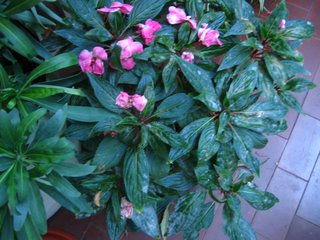
I mentioned a few posts back that weeds aren't a particular problem when you balcony garden, but that things do sometimes float in on the wind and seed themselves in the containers. And sometimes they can be quite interesting plants - so when I saw this one sprouting at the beginning of the summer, I popped it into a pot to see what would develop.
What is it? No idea - some sort of succulent it seems. I was sure I'd never seen it before - it's not something I've noticed growing wild, but nor is it anything I've ever seen in a garden.
Well - not till a few days ago that is, when I was walking through the garden at the front of the house and found this, crawling its way up a lamp post ....

Quite possibly the ugliest plant I've ever seen.
How did it get there? That's not a plant that's been deliberated over in a condominium assembly for at least three hours and until blood has been spilled (mandatory for any decisions regarding the condominium). Someone has had the thing growing on their balcony and, in desperation, crept into the garden at dead of night and stuck it up the lamp post. Look how awkward it looks - that, I'm sure, is no natural climber.
To me, it looks as if it should be snaking its way insidiously across the ground. Did someone actually go out and buy it (worthy of a post on Great Gardening Mistakes of the Century) and thus infect my balcony, or did it float in on the wind to them too? I can imagine hundreds of the things spreading through the garden, choking the shrubs and the trees, and then reaching unstoppably for the buildings. We'll all wake up one morning murdered in our beds, tendrils sliding through the shutters and wound mercilessly around our throats.
Because I'm sure it's conscious and I don't think it's from this planet. Who said that intelligent life must be animal? This is something out of The Day of the Triffids or The War of the Worlds. It's here to take over, to wipe us out ...
And I'm growing one. No question that it's the same. Compare the close-up below with the photo of my little one in its pot. Should I kill mine now, bringing upon myself the certain wrath of its kin, or should I go on nurturing it, in the hope that when the time comes I'll be spared and kept on as some sort of servant? They'll need someone to bring the fertiliser, for heaven's sake.

The monster in the garden is already starting to evolve. Did the person who planted it there think he was rendering it harmless by tying it to a stake? He's only increased its rage, and sooner or later we're all going to pay. Look at those little bubble things on the tips of the "teeth" on the leaves. Spores which spread silently on the wind ...
Alert your Neighbourhood Watch. Write to your Congressperson. Notify NASA. But don't ever say I didn't warn you...
Read more...






















